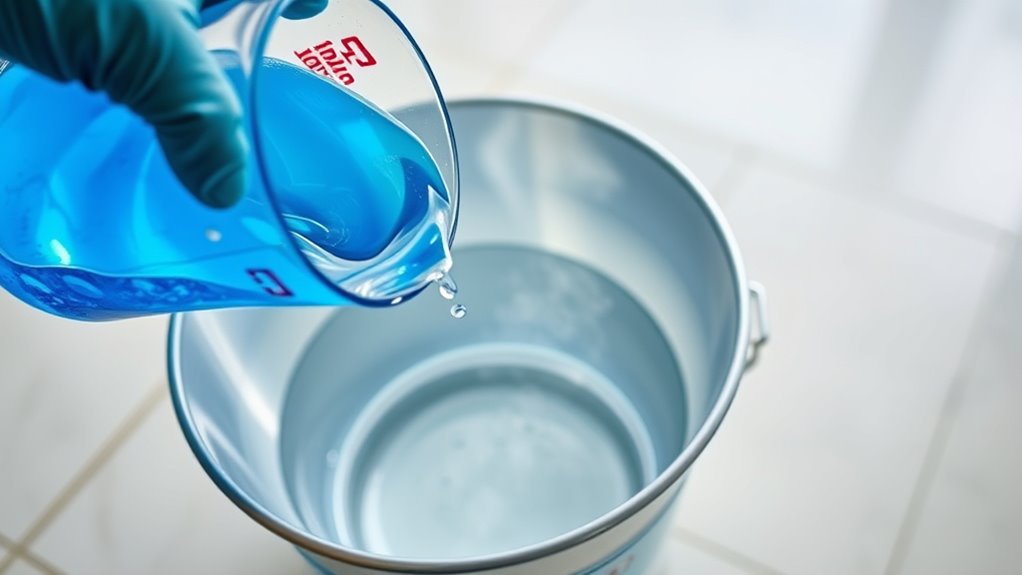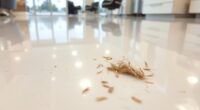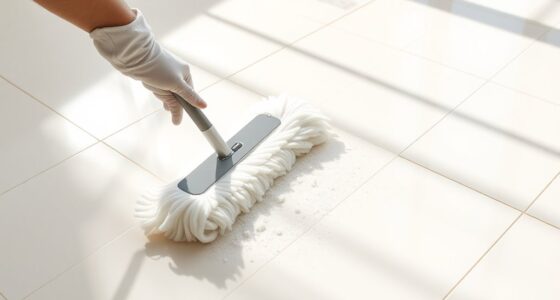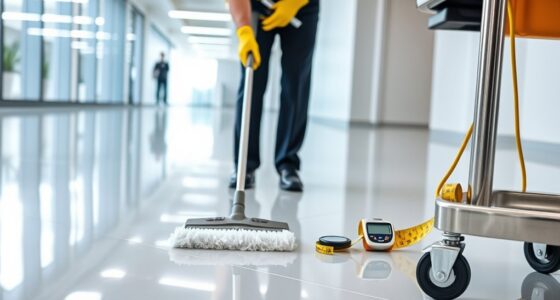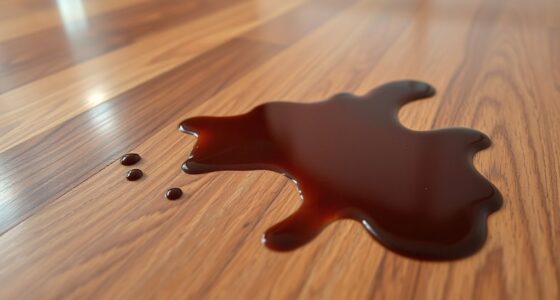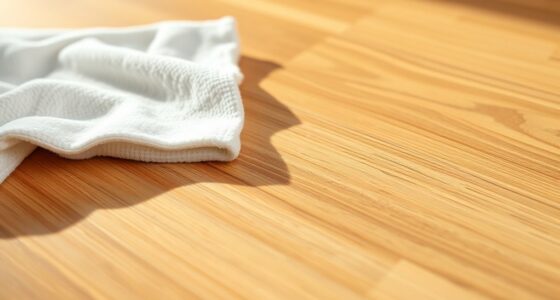To dilute floor cleaning chemicals correctly, start by carefully reading the manufacturer’s instructions for the recommended ratio. Use measuring cups or graduated containers to guarantee accuracy, avoiding guesses. Mix the solution in a well-ventilated area with protective gear like gloves and goggles. Test the diluted solution on a small corner before full use to prevent damage. Proper dilution not only keeps your floors safe but also maximizes cleaning effectiveness—learn more about safety and best practices as you continue.
Key Takeaways
- Always read and follow the manufacturer’s instructions for recommended dilution ratios.
- Use accurate measuring tools like cups or graduated bottles to ensure proper mixing.
- Mix chemicals in well-ventilated areas while wearing protective gear such as gloves and goggles.
- Test the diluted solution on a small, inconspicuous area before full application.
- Store leftover solutions in labeled, secure containers away from children and pets.
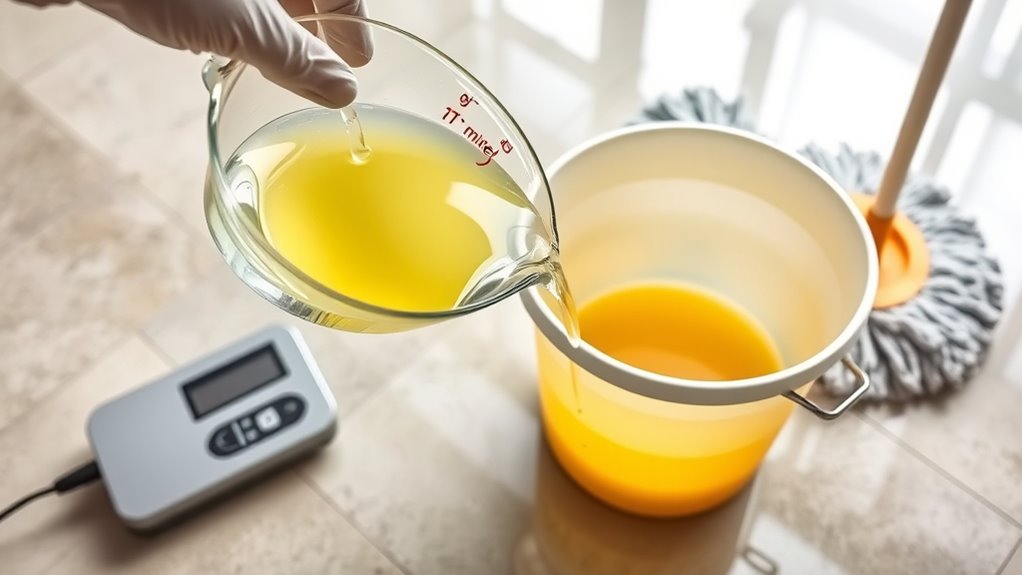
Diluting floor cleaning chemicals properly is vital to guarantee effective cleaning and prevent damage to your floors. When you handle these chemicals, safety should always be your top priority. Chemical safety isn’t just about wearing gloves or masks; it also involves using the correct dilution ratios to minimize risks and guarantee the cleaning solution works as intended. Using too much chemical can leave residues that harm your flooring, while too little may leave dirt and grime behind. That’s why understanding and following proper dilution ratios is essential. These ratios tell you precisely how much concentrate to mix with water, giving you the right strength for the job.
Proper dilution of cleaning chemicals ensures safety and effective floor cleaning without damage.
To start, always read the manufacturer’s instructions carefully. Labels typically specify the recommended dilution ratios, which are based on the type of floor and the level of dirt. For example, a general-purpose floor cleaner might require mixing one part chemical to ten parts water, but heavily soiled areas may need a stronger solution. Conversely, delicate surfaces like hardwood or laminate might need a more diluted mix to prevent damage. Stick to these guidelines without improvising, as improper dilution can compromise both safety and effectiveness. Remember, using the right dilution ratios not only guarantees ideal cleaning but also reduces chemical waste and exposure.
Next, guarantee you measure your chemicals accurately. Using measuring cups, graduated bottles, or pipettes helps you stick to the correct ratios. Avoid eyeballing or estimating, as even small errors can lead to ineffective cleaning or floor damage. When mixing, do so in a well-ventilated area and wear appropriate protective gear, such as gloves and goggles, to reinforce chemical safety. Once the solution is prepared, label it clearly, especially if you’re making a large batch for multiple uses. Proper labeling prevents accidental misuse and helps you keep track of when the solution was made, ensuring it remains effective and safe to use. Additionally, understanding the importance of chemical safety can significantly reduce potential hazards during cleaning.
Finally, always test your diluted solution on a small, inconspicuous area of your floor first. This step confirms that the mixture won’t cause discoloration or damage. If the test looks good, proceed with cleaning the rest of the area. After use, store any leftover diluted solution in a secure, labeled container away from children and pets. By paying close attention to chemical safety and dilution ratios, you guarantee your cleaning process is both safe and effective, protecting your floors and your household in the long run.
Frequently Asked Questions
Can I Reuse Leftover Diluted Cleaning Solution?
Yes, you can reuse leftover diluted cleaning solution if it still meets dilution guidelines and hasn’t been contaminated. However, be cautious with chemical reuse, as the solution may lose effectiveness or become unsafe over time. Always store it properly and check for any signs of spoilage. To guarantee safety and cleaning efficiency, follow proper dilution guidelines each time and avoid reusing solutions that have been sitting for too long.
How Do I Store Concentrated Chemicals Safely?
Storing concentrated chemicals safely is essential—they’re more powerful than a rocket launch! Always use proper chemical storage containers, clearly label them, and keep them in a cool, dry, well-ventilated area away from children and pets. Follow safety precautions like wearing gloves and goggles when handling, and never mix chemicals inappropriately. Proper chemical storage prevents accidents and keeps everyone safe, so treat these substances with the respect they deserve.
What PPE Should I Wear When Diluting Chemicals?
When diluting chemicals, you should wear appropriate protective gear, including gloves, goggles, and a mask or respirator if needed. Follow handling procedures carefully to prevent splashes or inhalation of fumes. Confirm your clothing covers exposed skin, and work in a well-ventilated area. Always read the chemical’s safety data sheet for specific PPE requirements, and never skip protective gear to stay safe during the diluting process.
Are There Eco-Friendly Alternatives to Chemical Cleaners?
Yes, there are eco-friendly alternatives to chemical cleaners. You can choose biodegradable options and natural cleaning agents like vinegar, baking soda, and lemon juice. These products are effective for cleaning floors and are safer for the environment, your family, and pets. By switching to natural cleaning agents, you reduce chemical exposure and promote a healthier home while still maintaining cleanliness. Always follow proper dilution instructions for best results.
How Often Should I Dilute and Change the Solution During Cleaning?
You should dilute your floor cleaning solution according to the manufacturer’s instructions and modify the concentration based on the cleaning frequency and dirt level. Change the solution regularly, ideally after each room or when it becomes visibly dirty or cloudy, to guarantee effective cleaning. Regular concentration adjustments help maintain cleaning power, and changing the solution prevents residue buildup, ensuring your floors stay clean and safe for everyday use.
Conclusion
Now that you’ve learned how to dilute your floor cleaning chemicals properly, you can confidently tackle messes without wasting product or risking damage. Remember, even in the age of steam-powered robots, following the correct dilution instructions remains essential for a sparkling, safe floor. So, don’t be a knave—measure carefully, and enjoy a pristine surface that’s as shiny as King Arthur’s armor. Clean smart, and your floors will thank you!
